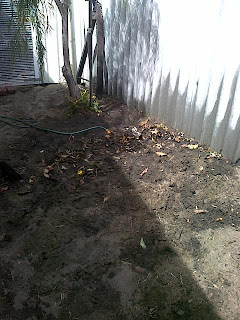Still, our garden is looking good. The water level in the tank is down by about one third. I have been watering twice a day, al;hough my friend told me that watering once every few days with a decent amount of water is better for the plants as it encourages the roots to grow deeper. But still I love hand watering with my watering can and so far have kept it to 60-70 liters a day.
After the third bed got prepared I left it for a few days until I planted the capsicums. My Macedonian gardening friend gave me a few different varieties, peppers and capsicum, some hot, some not. I distributed them over two beds, 10-15 each bed. I wonder who will eat all the harvest, but we are not there yet. My friend freezes the capsicum after drying it in the oven. She also gave me a thick vegetable onion. I knew about this variety, as my mother grows them in Germany. Great sweet veggies for soups.
On Saturday I took my remaining capsicum seedlings to another friend, an organic grower who lives in the city not far away. She showed me through her magnificent garden. A diversity of plants everywhere with lots of natural shade from trees and many other plants under shade cloth. She grows most veggies in raised garden beds as she is an elderly lady who has mobility issues. I came home with a bucket full of lemons and the idea to name the different garden beds. She gives her garden beds a proper name and not just a number. Have to speak to Jules about what names we could use, or may be we simply number them in Italian numbers. Or may be Italian cities. Friends of mine who own a flower farm near Darwin named their vehicles over the years in alphabetical order, starting with a they now have reached S, they have been in the business for a while.
Last week I set up a new batch of compost. We used a lot of shredded fresh cuttings, a big bush of rosemary went in and gave the compost an instant nice smell. We shredded newspaper and the neighbour came over because of the loud noise of the petrol run machine. Jules got a lot of veggie leftover from the markets, three full bags. I got the big chopping board and a decent knife and cut the stuff fine enough over three days, the last lot went in on Wednesday. I also added worm mixture and sheep poo.
My raised garden bed (colour bond, steel) is three metres long and 1m high, it is still in two pieces, waiting to find a place in the garden. We decided to cut it in half and use it for two raised beds. It makes sense cut it in half, as the plants only use the top 30-50cm of the soil anyway. We decided on the places where to put them, one will go under the ficus tree protecting it from the scorching summer heat and the other one will go next to the back door under a wattle tree. I want to plant beans and have checked my sortiment of seeds for other potential summer crops, freely polinated varieties for sure.
All plants are in good order, they look healthy and happy. Biggest growth was with a zucchini plant which is four times the size of before. The tomatoes have been stinged up between fence droppers, to help them cope with the recent heavy winds. the potatoes are doing find. they are shaded from the morning and afternoon sun, but struggle a bit in the midday sun and we are thinking about using an old swing set as a share house for that patch.
A friend told me about the Organic Association of WA. I will make contact and join that group, they sound like sensible people. I also thought about setting up a gardening chat at the Loftus Community Centre. I am sure that we have many people in my direct neighbourhood who would love to learn hos to grow healthy food.
I noticed the big difference the garden has made in my life. I love hand watering each plant, talking to it and sending out good energy for it to grow. It gives my day order and meaning. I happily get up around 6am to water and check on the plants, smiling when I fill up the water tank.I harvested the first three strawberries, sharing the berries carefully with my children. Small but sweet! Great reward for the two bottles of beer that I sacrificed as slug traps.
Mother earth knows that we care and every little bit counts.










